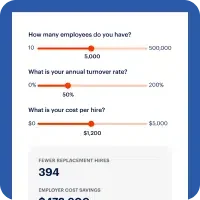This post has been updated to reflect new data and trends in employee turnover. Learn how to address turnover in the restaurant/QSR industry and hospitality industry in our industry blog series
Monitoring and calculating the true costs of employee turnover is an important mission for any business. However, fully understanding turnover costs can be difficult, since many qualitative and quantitative factors determine the cost of turnover for a business. By tracking patterns of employee churn, companies may be better equipped to identify and minimize causes of turnover, which can help protect their bottom line.1
Calculate the cost of employee turnover
Turnover is expensive for businesses. It is estimated that employee turnover can cost 1.5 to 2 times each employee’s salary, depending on their seniority, length of tenure and other factors. The average cost to replace an hourly worker is $1,500. Replacing technical employees can cost 100-150% of their salary, while replacing someone in the C-Suite can cost 213% of their salary.2
It may be difficult to determine the exact cost of qualitative losses, such as a decrease in morale, but some important factors should be considered, including:
- Productivity loss from disengaged, unhappy employees3
- The cost of hiring new employees, including recruiting, screening and interviewing
- Time spent on orientation, training and employee onboarding
- Ramp-up time for new employees
Alternatively, DailyPay’s employee turnover cost savings calculator can help you determine what your company’s annual savings could be after increasing retention rates.4 To use the tool, you simply need to input your company’s number of employees, turnover rate and cost per new hire to see your estimated annual savings.
Determine who’s most likely to quit
According to the Bureau of Labor Statistics (BLS), there are patterns in employee churn. Employees in service-based occupations, specifically the food service industry, have some of the lowest tenures due to low wages and lack of quality benefits.6 The median worker in the food service industry will quit just before the two year mark.⁵
Median employee tenure was generally higher among older workers than younger ones. For example, in 2020, the median tenure of workers ages 55 to 64 (9.9 years) was more than three times that of workers ages 25 to 34 years (2.8 years).⁵
The short tenures for younger workers could pose a problem in the near future. According to Pew Research, millennials have surpassed Generation X to become the largest share of the American workforce, meaning that a large portion of your staff may be at risk for leaving.
Examine the causes of employee churn
Turnover rates for hourly workers can be up to 3 times the turnover rates for salaried workers.8 Hourly waged workers, especially those who are unable to earn overtime, tend to earn less than salary workers. To feel more financially secure, workers earning low wages might keep an eye out for new opportunities that may pay better or offer more advantageous payment plans.
Disengagement in the workplace is also a sizable contributing factor to turnover costs. According to a 2021 Gallup Poll, only 36% of employees are engaged in their jobs, with 15% reporting that they’re actively disengaged.9 While turnover rates may vary from organization to organization, the least engaged employees tend to have the highest turnover rates.
Reduce turnover in your organization
To help increase employee retention, many companies are now offering improved benefits that keep up with today’s fast-paced world. On-demand pay is a benefit that’s growing in popularity in today’s digital landscape, with DailyPay recognized as the gold standard provider.
A study from the Mercator Advisory Group, “Modernizing Payroll Through Earned Wage Access,” reveals the true transformative power that DailyPay has on a company’s bottom line. Mercator’s research focused on some of the major industries DailyPay serves, calculating how much turnover decreased after implementing this benefit. Some notable results are as follows:
- Nursing homes- 73%
- Transportation- 68%
- Call centers- 51%
- Caregivers- 27%10
This data suggests that helping your employees feel valued and more financially secure may help them stay with your company longer, which may reduce turnover and the associated costs.
Want to see how DailyPay may be able to help your organization battle employee churn?
All information herein is for educational purposes only and should not be relied upon for any other use. The information herein does not constitute the rendering of financial business, accounting, securities, tax, legal advice, or other professional advice by DailyPay. No fiduciary obligation or duty exists or is created, between you and DailyPay. DailyPay does not warrant the completeness or accuracy of any information provided to you.
1 https://www.dailypay.com/resource-center/employee-retention/:DailyPay, 2020
2 https://builtin.com/recruiting/cost-of-turnover:DailyPay, 2020
3 https://www.entrepreneur.com/article/246036:DailyPay, 2020
4 https://www.dailypay.com/employee-turnover-calculator/:DailyPay, 2020
5 https://www.bls.gov/news.release/tenure.nr0.htm:DailyPay, 2020
6 https://www.nrn.com/workforce/more-restaurant-employees-are-quitting-any-other-industry-recent-data-shows:DailyPay, 2020
9 https://www.gallup.com/workplace/352949/employee-engagement-holds-steady-first-half-2021.aspx:DailyPay, 2020
10 https://www.dailypay.com/mercator-report-2021/:DailyPay, 2020













